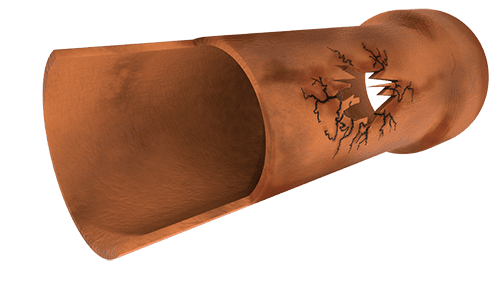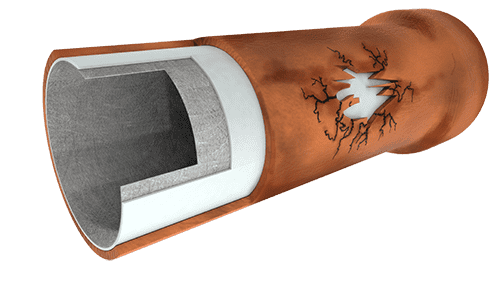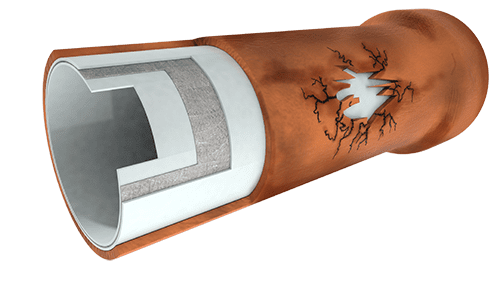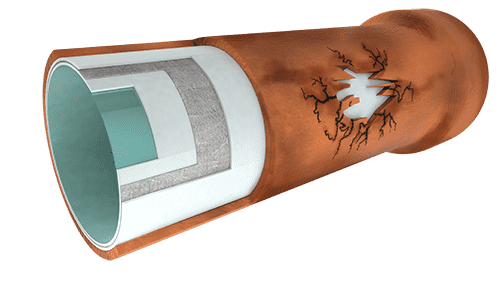At Applied Felts, we’ve been pioneering the CIPP lining manufacturing process for more than 40 years. We’re proud to say that our innovative CIPP manufacturing methods have revolutionized the global industry, with companies worldwide using our techniques every day.
We create custom pipe repair solutions for our clients, manufacturing CIPP liners and accessories that provide an affordable and safer alternative than traditional pipeline rehabilitation methods, such as open-cut repairs.
Applied Felts is a 100% vertically integrated liner manufacturer, which guarantees that every phase of manufacturing – from the purchase of raw fiber to the coating and development of our liners – is done in one location, giving us impeccable precision and control over the quality products we make. Our innovative liners are subjected to a rigorous 28-stage testing system during every phase of the manufacturing process:
Why do we go to such extremes to ensure the liners you receive will be the highest quality available? Because your success is our success.
The cured-in-place pipe (CIPP) liner was a revolutionary invention in the world of gravity sewer line, pressurized, and water potable pipe repair, consisting of a resin-soaked felt with an impenetrable, polyurethane-coated exterior.
During CIPP installation, the liner adheres seamlessly to the interior of the damaged host pipe, creating a pipe-within-a-pipe. It’s a quick, cost-effective alternative to traditional pipeline rehabilitation methods like digging large-scale trenches or open-cut repair.
Existing pipelines that are leaking, broken, or malfunctioning not only pollute the environment but they’re wasteful, costly, and downright dangerous. Using a CIPP liner is not only safer than open-cut repair, but it’s also cheaper, faster, and less disruptive to the community and surrounding environment.
As a CIPP liners manufacturing company that’s well-established and respected within the industry, we are proud of the innovative process we use to produce our liners, including 28-stage quality assurance testing. What makes our manufacturing and CIPP installation process the gold standard for cured-in-place pipe manufacturers around the world? Let’s find out:
Initial Inspection: The raw materials we use undergo a rigorous inspection and testing method to ensure strength, durability, and premium quality. Our liners consist of felt, polyester, polyurethane, and resin.
Five-Stage Production: After we select the highest-quality felt and discard the rest, we use a five-stage production process, testing for strength, flexibility, density and thickness, fiber distribution, and overall weld-ability.
Single-Pass Felt Coating: Our exclusive “single-pass” felt coating process eliminates any pinholes, but we still perform four separate tests to ensure that the coating is uniform and evenly distributed for a flawless finish.
Multi-Step Testing: Post-coating, each felt roll undergoes even more testing. We sample and destruct each liner to test its quality using nine unique characteristics, including coating distribution, tensile strength, and density under pressure. Our staff conducts these tests continually during each phase of the manufacturing process, ensuring that each CIPP liner has the exact specs needed for its intended application.
Post-Production Quality Assurance: Even after we finish the manufacturing process, our CIPP liners undergo still more testing across seven criteria to ensure superior quality, including weld strength, coating integrity, diameter and length, density, and more.
Why do we use such a meticulous and exacting testing process for our CIPP liners? It’s simple: we go above and beyond for every client to ensure that our CIPP lining not only meets but exceeds their specifications.
At Applied Felts, we’re proud to be an industry leader in CIPP liner manufacturing, providing a safer, more efficient alternative to traditional pipeline rehabilitation and repair. Use our online contact form to reach one of our offices in the U.S., United Kingdom, or India.







Applied Felts
Castle Bank Mills
Portobello Road
Wakefield
West Yorkshire WF1 5PS
t: 44.1924.200535
f: 44.1924.366951

Applied Felts, Inc.
450 College Drive
Martinsville, VA 24112
t: 276.656.1904
f:: 276.656.1909

Applied Felts India, Pvt. Ltd.
Shahpur Road
Sikri, Ballabgarh
District Faridabad
Haryana -121004
T: +91 9871392645
For inquiries within the Americas and Canada: info@appliedfelts.com
For Inquiries outside of the Americas and Canada: sales@appliedfelts.com
For Sub-Continent Inquiries only: info@appliedfeltsindia.com
This website uses cookies.
Privacy settings
Privacy Settings
This website uses cookies to improve your experience while you navigate through the website. Out of these cookies, the cookies that are categorized as necessary are stored on your browser as they are as essential for the working of basic functionalities of the website. We also use third-party cookies that help us analyze and understand how you use this website. These cookies will be stored in your browser only with your consent. You also have the option to opt-out of these cookies. But opting out of some of these cookies may have an effect on your browsing experience.
To view our Privacy Policy, click here.
NOTE: These settings will only apply to the browser and device you are currently using.
Cookie Policy
This website uses cookies to improve your experience while you navigate through the website. Out of these cookies, the cookies that are categorized as necessary are stored on your browser as they are as essential for the working of basic functionalities of the website. We also use third-party cookies that help us analyze and understand how you use this website. These cookies will be stored in your browser only with your consent. You also have the option to opt-out of these cookies. But opting out of some of these cookies may have an effect on your browsing experience.